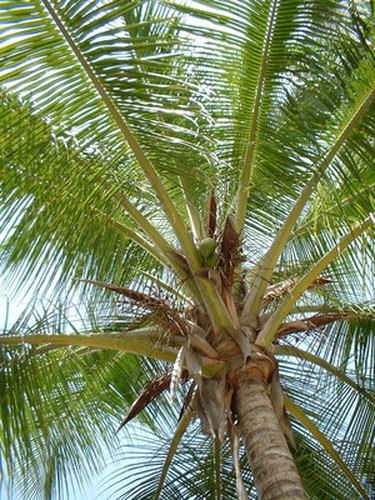Things You'll Need
Shovel
Peat
Sand
Topsoil
Mulch
Palm fertilizer
Sharp knife
Pole-handled pruning saw

Coconut palm (Cocos nucifera) is a tropical fruit tree. According to the University of Florida, coconuts have been known to float across oceans before landing and rooting on distant beaches. Coconut palms are easily grown from seed and will bear fruit after the age of 6. Once established, these trees need very little care. Different cultivars, from the fast-growing Jamaican Tall to the disease-resistant Malayan Dwarf grow well in the USDA Hardiness Zone 10 areas of South Florida, from mid-state down to Key West.
Step 1
Amend soil for coconut palms to a depth of 2 feet with a shovel if it does not drain well when you pour a bucket of water on it. Mix equal parts peat, sand and topsoil for a loose, nutrient-rich mix. Coconut palms will quickly die if left in standing water or are planted in soggy soil.
Video of the Day
Step 2
Water palms every few days in the first growing season after planting. After one year, water only during dry periods that last a week or more. Spread a 3-foot ring of mulch at a depth of 3 inches, 8 inches from the trunk of the palm. Mulch reduces competition from weeds, holds moisture near the roots in times of drought and regulates soil temperature.
Step 3
Fertilize palm trees every three months at a rate of 1 lb. of formulated palm fertilizer per 100 square feet of canopy. Water deeply after application for best results. Watch the coconut palms for yellowing of the oldest leaves or throughout the canopy, usually an indication of nitrogen deficiency. If you see this, make sure you're using the correct proportion of fertilizer for the size of the tree.
Step 4
Prune away wilted leaves with a sharp knife only when they are completely dead, brittle and brown all the way down the stem. Cutting even a partially green stem can cause injury to the palm. Leave a half-inch stub when you prune, to avoid injury to the trunk bark.
Step 5
Harvest coconuts with care. If you are not an experienced climber, use a pole-handled pruning saw to cut coconut stems. Never climb coconut palm with tree-climbing spikes because they will puncture the bark and provide entry for insects and fungus.
Tip
Grow coconuts from seed by laying them on their sides and covering with sandy soil so that the top 2 inches of the nut is above the soil line. Keep consistently moist and warm, and the coconut will sprout in about a month.
Warning
Don't plant fast-growing coconut palms where they can overhang your house or driveway. It takes a long time for a coconut to grow, but it can cause serious property damage when it drops from the tree.
Video of the Day